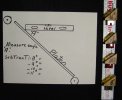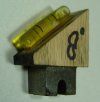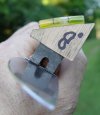- Joined
- May 2, 2004
- Messages
- 6,848
I don't believe I have ever seen or heard at what angle you should be grinding your blades. The angle between the platen and the piece of steel you are grinding. Is there some rule of thumb. I did not have an answer. So, in my usual ass backwards fashion, I set out to find an answer. I made up this small bubble with a magnet attached to it. The idea was to set the bubble/mag on the ricasso while I was grinding. Through trial and error, I finally came up with one where the bubble would float when I held the blade at what I considered a good grinding angle. Using a compass I measured the angle between the platen and the steel being ground. I found that 11degrees angle off the platen was about right for a narrow blade, say 5/8", and around 8 degrees for a big blade, 11/2". I took this information and made up 4 bubble/mag jigs. These little 50cent jigs allow me to grind at the same angle every time I place the blade against the grinding belt. I put a piece of double sided tape on both sides of the ricasso,set the approiate bubble/mag jig on the tape, float the bubble and grind. When you move to the opposite side to grind you will have the exact same angle. These jigs are great when you are trying to get all four bevels of a dagger even. Materials used; 3/4" ply, bubble from old level, drug store magnet and epoxy. Proceedure; measure angle "A" subtract 8to 11degrees, cut angle on top of wood block and epoxy. Fred 



